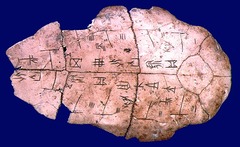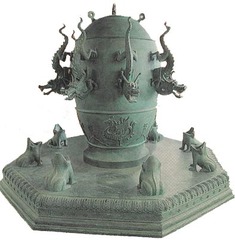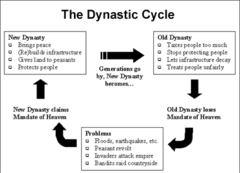Ancient China Ch 3 and 4
Unlock all answers in this set
Unlock answersquestion
dynasty
answer
a line of rulers belonging to the same family
question
Shang Dynasty

answer
(1766-1122 BCE) First significant Chinese dynasty. United the Huange He (Yellow) River Valley. Advancements include pictographic writing system (on oracle bones) and bronze metallurgy. Declined when overpowered by the Zhou
question
oracle
answer
a priest who is believed to tell the future
question
oracle bone

answer
A group of inscribed animal bones and shells discovered in China, and used originally to tell the future by the ancient Chinese, especially during the Shang dynasty; first examples of writing in China
question
Anyang
answer
the ancient Chinese capital of the Shang Dynasty
question
Zhou Dynasty
answer
this dynasty is China's Classical Age- a time of great growth and creativity; they overthrew the Shang Dynasty; used a feudal system; overtook Yangtze River Valley (Middle Kingdom); invoked the \"Mandate of Heaven\"
question
feudalism
answer
a social, political, and economic system based on land, loyalty, and protection, not centralized...nobles hold much power
question
Warring States Period
answer
time of warfare between regional lords following the decline of the Zhou dynasty in the 8th century B.C.E. lasting until unification by Shihuangdi of the Qin dynasty
question
Qin Dynasty
answer
China's first empire; established by Shihuangdi; very strict legalism; Great Wall built
question
Shihuangdi
answer
he created China's first empire; strong centralized government (strict...legalism) single system of writing, roads size, weights and measures, and money; connected and extended four old fortification walls along the north of China to begin the Great Wall of China; tomb clay army
question
The Great Wall of China
answer
massive defensive structure made from mounded earth, rock, and masonry; designed to defend China from the nomadic invaders of the North; more than 4,000 miles long; begun by Shihuangdi
question
terracotta army/ Silent Army
answer
Shihuangdi's tomb -had a huge number of clay soldiers built (rediscovered in 1974) 8000 soldiers, 130 chariots, 520 horses; 210 BCE;
question
censorship
answer
banning or destroying material or information (often written); example- book burning; Shihuangdi burned many books during the Qin dynasty
question
dissent
answer
difference of opinion or feeling; disagreement; the refusal to conform to the authority
question
Mandate of Heaven
answer
the belief that the Chinese emperor's right to rule came from the gods, so a gov't. must rule fairly or be overthrown
question
Liu Bang
answer
peasant who led rebellion to overthrow the Qin dynasty and establish the Han dynasty; justified rebellion with the Mandate of Heaven
question
Han Dynasty

answer
(226 BCE-220 CE) Chinese dynasty that replaced the Qin. under Han rule, the empire expanded; based gov't on Confucian ideas; founded a bureaucracy for which officials had to take an exam; invented paper, seismograph, wheelbarrow; made advances in silk making and fine china; Pax Sinica and Silk Road
question
Wudi
answer
greatest emperor of the Han dynasty; expanded the empire
question
Silk Road

answer
trade route that connected China with western Asia (Fertile Crescent) ; silk was brought to the west
question
Pax Sinica
answer
Chinese peace; under the Han Dynasty, China experienced 400 years of prosperity and stability
question
The Five Classics
answer
the books that formed the basis of Chinese literary style; used by Confucianism as the basis of study
question
Sima Qian
answer
a historian during the Han dynasty who wrote first true history of China
question
Civil Service system
answer
the practice of hiring goverment workers on basis of open competitve examinations and merit
question
bureaucracy
answer
the administrative structure of a large or complex government composed of bureaus or departments staffed with nonelected officials
question
Mandarins
answer
a class of well-educated civil servants that controlled the government bureaucracy in imperial China
question
Confucius

answer
(551-479 BCE) Chinese philosopher and writer of The Analects, a collection of moral and social teachings, including the concept of the Five Relationships. He also stressed the need to respect tradition and that education is the key to happiness. Also known as Kong Fu Zi.
question
Confucianism
answer
Chinese philosophy that advocates the need to respect tradition and family, and that education was the key to happiness
question
5 Relationships Of Confucianism
answer
1. ruler to subject 2. husband to wife 3. father to son 4. elder brother to younger brother 5. friend to friend
question
filial piety
answer
In Confucian thought, one of the virtues to be cultivated, a love and respect for one's parents and ancestors
question
the Analects

answer
Collection of moral and social teachings of Confucius, including the concept of the Five Relationships.
question
Legalism
answer
philosophy that rejected Confucian ideas, emphasized strict laws and harsh punishments, believed humans were evil by nature & required a strong, forceful government to make them attend to their duties, and justified force and power = used by the Qin Dynasty
question
Daoism (Taoism)
answer
philosophical system developed by of Lao Zi advocating a simple, honest life and noninterference with the course of natural events
question
Lao Zi
answer
606-530 BCE Chinese philosopher and the founder of Daoism ( Taoism )
question
Yin and Yang

answer
the two opposing forces of nature; for harmony the 2 elements had to be in balance
question
Four Occupations

answer
1. Shi = gentry scholars 2. Nong = peasant farmers (90%) 3. Gong = artisans and craftsmen 4. Shang = merchants and traders
question
Chinese inventions:
answer
paper, silk, wheelbarrow, seismograph, suspension bridge, gunpowder, compass
question
Chinese seismograph

answer
instrument used by the ancient Chinese to measure earthquakes
question
Dynastic Cycle

answer
rise and fall of Chinese dynasties according to the Mandate of Heaven



